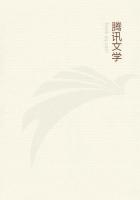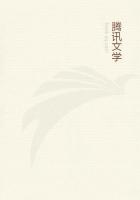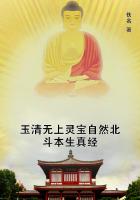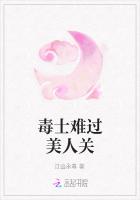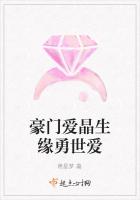The finest ears are plucked out of it and made into a wreath, which, twined with flowers, is carried on her head by the prettiest girl of the village to the farmer or squire, while the Corn-mother is laid down in the barn to keep off the mice. In other villages of the same district the Corn-mother, at the close of harvest, is carried by two lads at the top of a pole. They march behind the girl who wears the wreath to the squire's house, and while he receives the wreath and hangs it up in the hall, the Corn-mother is placed on the top of a pile of wood, where she is the centre of the harvest supper and dance. Afterwards she is hung up in the barn and remains there till the threshing is over. The man who gives the last stroke at threshing is called the son of the Corn-mother; he is tied up in the Corn-mother, beaten, and carried through the village. The wreath is dedicated in church on the following Sunday; and on Easter Eve the grain is rubbed out of it by a seven-year-old girl and scattered amongst the young corn. At Christmas the straw of the wreath is placed in the manger to make the cattle thrive. Here the fertilising power of the Corn-mother is plainly brought out by scattering the seed taken from her body (for the wreath is made out of the Corn-mother) among the new corn; and her influence over animal life is indicated by placing the straw in the manger. Amongst the Slavs also the last sheaf is known as the Rye-mother, the Wheat-mother, the Oats-mother, the Barley-mother, and so on, according to the crop. In the district of Tarnow, Galicia, the wreath made out of the last stalks is called the Wheat-mother, Rye-mother, or Pea-mother. It is placed on a girl's head and kept till spring, when some of the grain is mixed with the seed-corn. Here again the fertilising power of the Corn-mother is indicated. In France, also, in the neighbourhood of Auxerre, the last sheaf goes by the name of the Mother of the Wheat, Mother of the Barley, Mother of the Rye, or Mother of the Oats. They leave it standing in the field till the last waggon is about to wend homewards. Then they make a puppet out of it, dress it with clothes belonging to the farmer, and adorn it with a crown and a blue or white scarf. A branch of a tree is stuck in the breast of the puppet, which is now called the Ceres. At the dance in the evening the Ceres is set in the middle of the floor, and the reaper who reaped fastest dances round it with the prettiest girl for his partner. After the dance a pyre is made. All the girls, each wearing a wreath, strip the puppet, pull it to pieces, and place it on the pyre, along with the flowers with which it was adorned. Then the girl who was the first to finish reaping sets fire to the pile, and all pray that Ceres may give a fruitful year. Here, as Mannhardt observes, the old custom has remained intact, though the name Ceres is a bit of schoolmaster's learning. In Upper Brittany the last sheaf is always made into human shape; but if the farmer is a married man, it is made double and consists of a little corn-puppet placed inside of a large one. This is called the Mother-sheaf. It is delivered to the farmer's wife, who unties it and gives drink-money in return.
Sometimes the last sheaf is called, not the Corn-mother, but the Harvest-mother or the Great Mother. In the province of Osnabrück, Hanover, it is called the Harvest-mother; it is made up in female form, and then the reapers dance about with it. In some parts of Westphalia the last sheaf at the rye-harvest is made especially heavy by fastening stones in it. They bring it home on the last waggon and call it the Great Mother, though they do not fashion it into any special shape. In the district of Erfurt a very heavy sheaf, not necessarily the last, is called the Great Mother, and is carried on the last waggon to the barn, where all hands lift it down amid a fire of jokes.
Sometimes again the last sheaf is called the Grandmother, and is adorned with flowers, ribbons, and a woman's apron. In East Prussia, at the rye or wheat harvest, the reapers call out to the woman who binds the last sheaf, You are getting the Old Grandmother. In the neighbourhood of Magdeburg the men and women servants strive who shall get the last sheaf, called the Grandmother. Whoever gets it will be married in the next year, but his or her spouse will be old; if a girl gets it, she will marry a widower; if a man gets it, he will marry an old crone. In Silesia the Grandmothera huge bundle made up of three or four sheaves by the person who tied the last sheafwas formerly fashioned into a rude likeness of the human form. In the neighbourhood of Belfast the last sheaf sometimes goes by the name of the Granny. It is not cut in the usual way, but all the reapers throw their sickles at it and try to bring it down. It is plaited and kept till the (next?) autumn. Whoever gets it will marry in the course of the year.
Often the last sheaf is called the Old Woman or the Old Man. In Germany it is frequently shaped and dressed as a woman, and the person who cuts it or binds it is said to get the Old Woman. At Altisheim, in Swabia, when all the corn of a farm has been cut except a single strip, all the reapers stand in a row before the strip; each cuts his share rapidly, and he who gives the last cut has the Old Woman. When the sheaves are being set up in heaps, the person who gets hold of the Old Woman, which is the largest and thickest of all the sheaves, is jeered at by the rest, who call out to him, He has the Old Woman and must keep her. The woman who binds the last sheaf is sometimes herself called the Old Woman, and it is said that she will be married in the next year. In Neusaass, West Prussia, both the last sheafwhich is dressed up in jacket, hat, and ribbonsand the woman who binds it are called the Old Woman. Together they are brought home on the last waggon and are drenched with water. In various parts of North Germany the last sheaf at harvest is made up into a human effigy and called the Old Man; and the woman who bound it is said to have the Old Man.

